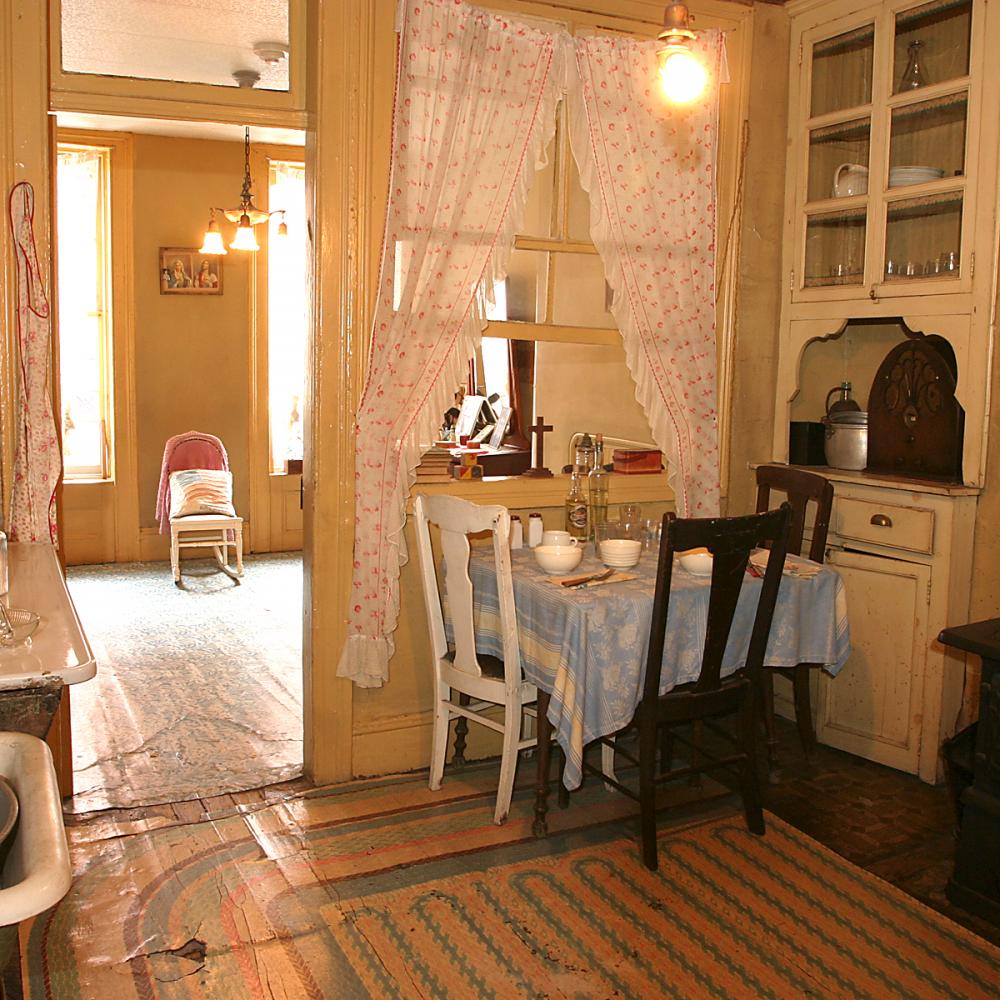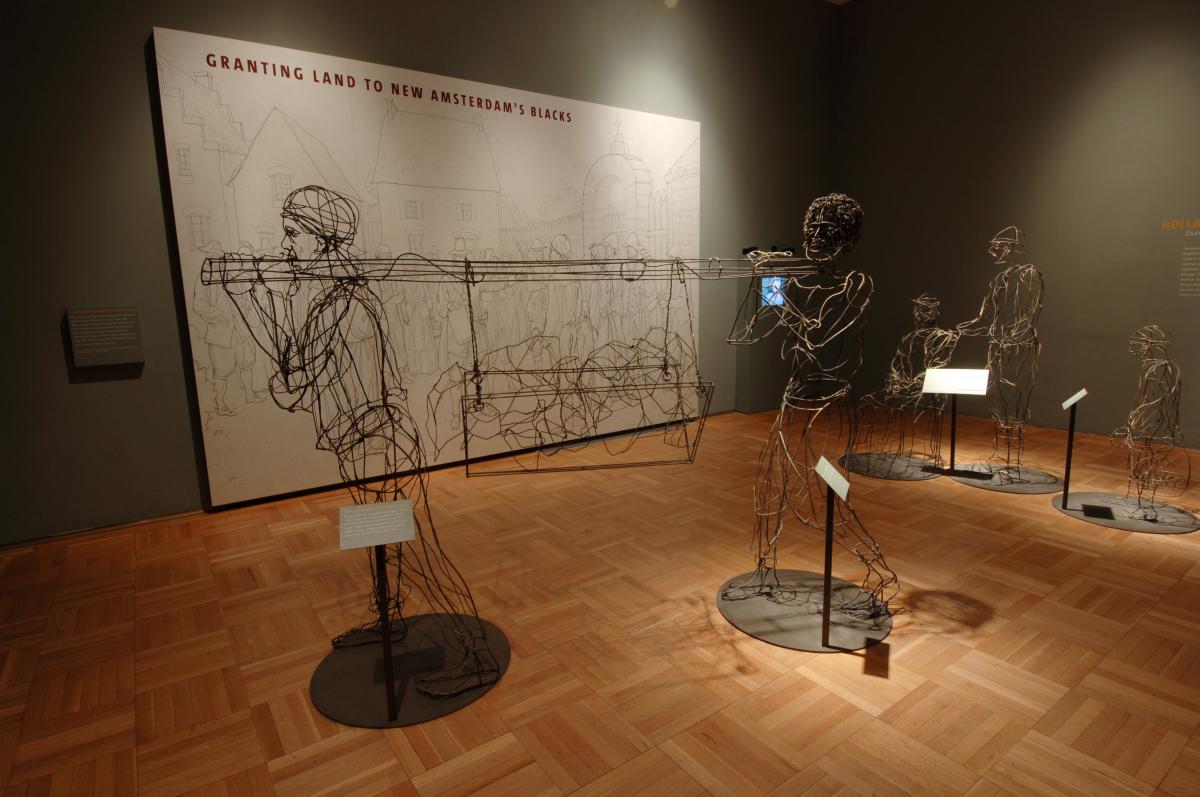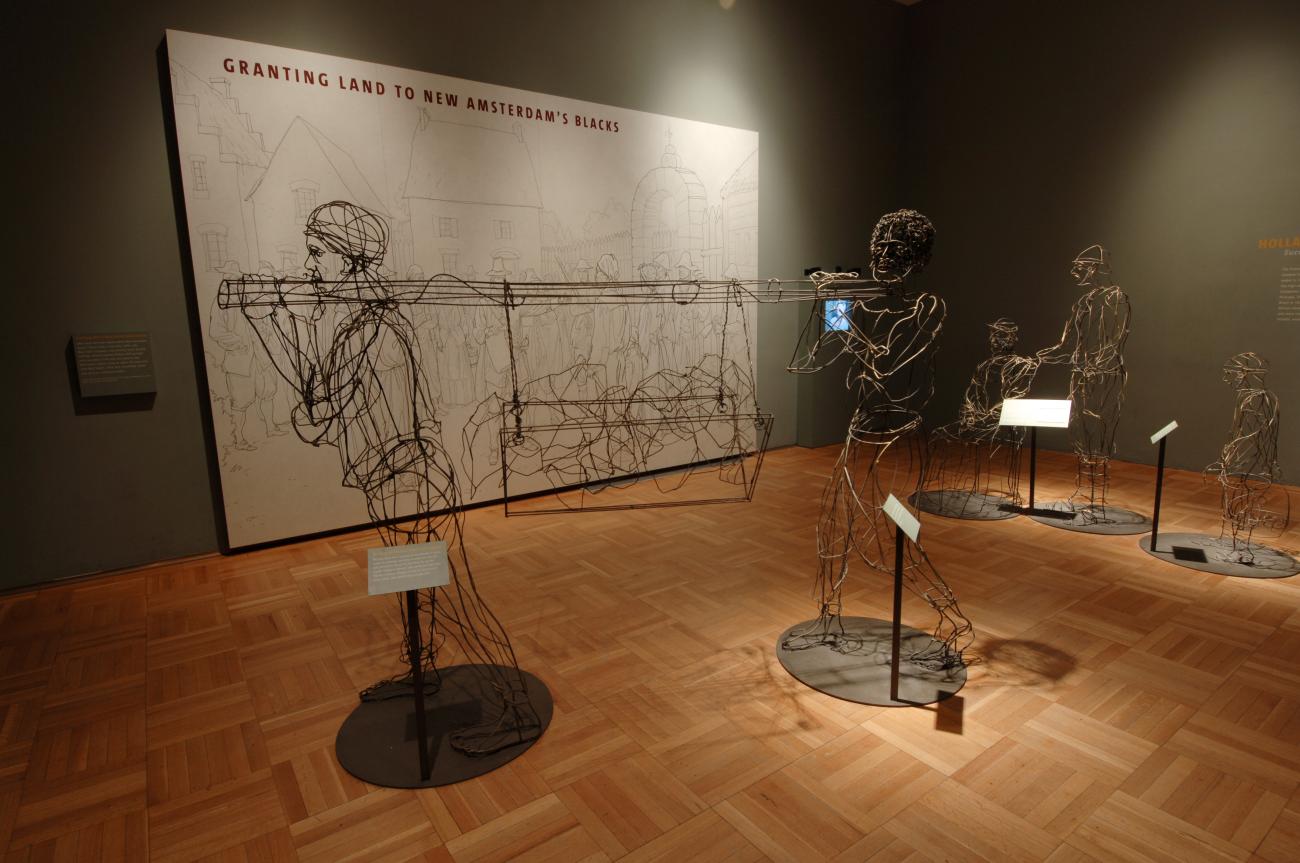“Take one step from the Charles, and you might find yourself in the Mekong!”
This is how the associate dean at Richard Rabinowitz’s graduate school replied when Rabinowitz broke the news that he was leaving Harvard to take a job as a costumed interpreter at Old Sturbridge Village in rural Massachusetts for $1.10 an hour. Rabinowitz was a luckier-than-average 21-year-old, studying American religious history on fellowship at one of America’s top universities, where he was safe from being drafted to fight in Vietnam. He was, however, “bored to tears,” he tells a crowd of college students gathered in the Luce Center at the New-York Historical Society. The students have come to hear one of America’s preeminent public historians give a speech on “Using Your History Major.”
Rabinowitz did not end up in the Mekong Delta, fighting for his life. Instead, the instinct that drove him away from the Ivory Tower and toward the mock village from the 1830s guided him over the next forty-one years to a celebrated career as one of America’s most respected developers of museum exhibitions. Through his company, American History Workshop, Rabinowitz has created more than five hundred successful and innovative history programs at sites such as the New-York Historical Society (N-YHS), the Lower East Side Tenement Museum, and Federal Hall, just to name a few in the New York area. His recent blockbuster exhibition for N-YHS, “New York Divided: Slavery in the Civil War” won him critical acclaim, as well as contracts to develop four new exhibitions, including “French Founding Father: Lafayette’s Return to Washington’s America,” which continues through the summer, and “Grant and Lee,” which opens in the fall.
Rabinowitz says he couldn’t have articulated it at the time, but as a stilted grad student in the winter of 1967, he had a sense that something was missing from his education. “I had an instinct,” he says, “that there was more to the way in which history should be studied than could be found simply in libraries, in written documents.”
An example of such learning came to him during an extensive oral history interview he once conducted with his mother, a Jewish immigrant from Poland. He asked her how his grandmother had prepared chicken during the family’s first years in America. “What time of year are we talking about?” she responded. Chicken back then, he discovered, differed in flavor and quality from season to season, and this “challenged the cook’s ingenuity” in a way that today’s supermarket chicken does not. “I realized,” he says, “that we don’t have so much of the knowledge of the past. It’s disappeared because our lives are so different. We don't know that chicken was once, not just organic, but it actually had variability. It wasn't an industrial product the way it is today in, you know, Frank Perdue’s world.”
“She had such extraordinary knowledge in her fingertips,” he tells the now-rapt crowd of college students. “That kind of learning,” he says, is what he saw at Old Sturbridge Village.
"Conveying the stuffitude"
Rabinowitz remembers his visit, on a Sunday in January 1967. Wearing loafers and chinos, he was unprepared for the cold he encountered inside the buildings of the historic village. His years of reading primary documents had never impressed on him such a basic reality of early American life. Of this visceral learning experience, he says, “it was a revelation that the world had this physicality to it, this materiality to it, this stuff—this stuffitude.”
Rabinowitz spent six years at Old Sturbridge Village, working his way up to director of education. In 1975, he went back to Harvard and finished his Ph.D., but was again bored by the inertia of academic life, with its endless meetings and bureaucracy. He quit for more project-driven work, consulting for small museums. One of his first completed projects was designing the “Cranberry Bog” at Ocean Spray’s Cranberry World. But work as a consulting historian was unsatisfying, with its “days of interviewing to get a three-day job.” After a stint working for the National Endowment for the Humanities, he decided to start American History Workshop (www.americanhistoryworkshop.com).
Since that January day at Sturbridge, first as a historic interpreter and later as a curator, Rabinowitz has dedicated himself to conveying the stuffitude of history. It is a process he sees as essentially theatrical, using the same dramatic and visual techniques that make, say, a great production of Macbeth into a life-altering experience. In the past, Rabinowitz has defined the vanguard of exhibition makers as “the playwrights of memory and its reputation,” setting them against the old guard or the ancien régime, the antiquarians and architectural historians who keep dusty objects in Plexiglas cases. Thinking outside of the box is not for him an idle play on words, but rather the foundation of his art.
A few weeks after his N-YHS address, Rabinowitz invites me into his brownstone home in the historic Park Slope neighborhood of Brooklyn to help me understand how the techniques of theater can transform remote figures in the past into human beings “who are just as complicated, just as thoughtful, just as confused as we are today.” In hushed tones, Rabinowitz, whom I had begun to think of as some kind of maverick showman, reveals himself to be a deeply serious man—serious about “entertainment,” he says, “in the best sense.” As we sit in his living room, surrounded on two sides by the books of great American thinkers, Rabinowitz describes the French idea of entertainment. The French make a distinction between filling the mind (entretenir) and amusing or diverting the mind (divertir). For Rabinowitz, entertainment is “not a diversion. It’s really focusing, in the way that you say, ‘I'm going to entertain your proposition.’ . . . That’s my kind of entertainment. I want to fill people's minds with the kind of idea that keeps them awake at night, that keeps them thinking.”
Staging the textual
By way of illustrating the special alchemy that distills texts into theater, Rabinowitz points to a book in his library—one of hundreds of almost identically bound volumes. “I have in this bookshelf,” he says, “a clear 1960s transcription of James Wilson’s draft of the 1787 federal Constitution. For purposes of reading it, I’d show you the passage in my library.” But for the exhibition “Miracle at Philadelphia” in 1986, he chose Wilson’s manuscript because it contained a telling imperfection: “On page seven of this document, James Wilson stops crossing out the word ’Governor’ and writing the word 'President,' and from there on the Chief Executive Officer of the United States he describes as President.” At that moment, he says, "the world turns." He continues with the lesson, “So what’s the difference between president and governor in 1787? God is never described as the president of the universe. . . . So moving from governor to president was a way of tempering or toning down the office.” And by displaying the draft, “you could actually see this happen in a single moment in time.”
Visually, Rabinowitz might display a document like this on the desk in front of a full-sized figure, posed, he says, “in such a way that you felt you were sort of stepping and looking over the five-foot-four guy, and you were looking over his shoulder as he was actually taking his notes.” He used this technique in the same exhibition to bring life to James Madison's notes on the Constitutional Convention—notes Rabinowitz calls “the Rosetta Stone of American Constitutionalism.” Without these, he says, “you would hardly know what happened in Philadelphia in 1787.” This technique is decidedly out-of-the-box, or, as it were, out of the Plexiglas case. “It’s not in a case as a reverential thing that should be just seen from afar and worshipped. It’s actually something that was actually written on rag paper by someone with a quill pen who took time and made mistakes.”
Life-sized sculpture techniques such as this played an even more evocative role in “New York Divided: Slavery and the Civil War,” which grappled with New York City's complex role as practitioner and beneficiary of slavery. When visitors entered “New York Divided,” they stood in the shadow of bales of cotton hanging from the ceiling. Once inside the exhibition, they learned that half of New York’s exports in 1822 were in the form of slave-picked cotton. A perceptive visitor walking through “Slavery in New York” would have been haunted by the ghostly sculptures peppering the exhibition area—black men and women that had been expertly formed out of wire, making them both transparent and unavoidable.
Such is Rabinowitz’s specialty—setting the scene for history’s unsettling details. The Lower East Side Tenement Museum (www.tenement.org), which Rabinowitz helped create in the mid-1980s, transports visitors from its now-fashionable Orchard Street, Manhattan, location directly into the homes and stories of immigrants at the turn of the twentieth century. The making of this exhibition was a turning point, both for Rabinowitz, and for the culture of museums as a whole. Rabinowitz told the crowd of students at N-YHS that while the 1970s had seen exhibition makers turn away from “dusty objects in rows” and toward the exploration of themes, the Tenement Museum initiated another turn, this time away from themes and toward actual stories.
The decision to tell the actual stories of actual families who actually lived in the restored building is the kind of idea so obvious that its genius was not readily apparent. The idea occurred to Rabinowitz’s team only after months of work on the project. Initially they had planned, in the style of the day, to devote each apartment in the tenement to a different immigrant group—one each to African Americans, Irish, Jews, Italians, etc. The stories would consist of composite sketches of hypothetical families. As it turned out, Rabinowitz told scholars gathered for the Beyond the Liberty Bell conference in 2003, “historians are not very good dramatists.” When researchers reported on the initial two families, German and Irish ones, he said, “both groups featured an intermarriage between Protestants and Catholics, an industrial accident in 19th-century New York’s dangerous trades that crippled the old man, the dangerous activity of a son in the city’s politics or social conflicts, and a daughter’s dangerous liaison across ethnic boundaries. It looked as though the museum would become an endlessly repetitive soap opera of immigrant tribulations, masking a lot of ethnic stereotyping.”
A fortunate discovery
The project was saved by the discovery of Natalie Gumpertz’s 1883 petition to have her husband Julius, who had abandoned the family nine years before, declared legally dead so that Natalie could inherit Julius’s East Prussian fortune. It was the kind of detail—the kind of stuffitude—that Rabinowitz lives for.
The Gumpertz family story, which can still be experienced several times a day at the Tenement Museum, illustrates another principle that underpins much of Rabinowitz’s work: the use of “sacred spaces” to forge a connection between visitors and people in the past. In his 2003 speech, Rabinowitz described creating exhibition spaces that are “treated as shrines. These are zones of reverence and remembrance separated from the arenas of storytelling themselves, where visitors may immerse themselves in the trials of historical figures.” In the same way that the Vietnam Veterans Memorial in Washington, D.C., invites visitors to take part in a highly emotional communion with the past, so the Tenement Museum offers an experience that is, for Rabinowitz, “sacred in a sense to my history” as the son of immigrants.
When walking into the museum’s 97 Orchard Street tenement, the first thing a visitor notices is how dark it is—and that is before the tour guide turns off the light bulb, installed for safety, that provides what little light there is. On my visit, I was struck by the transition from the clamorous street life outside to the dark, chapel-like air inside. A pair of chatty English women on the tour ahead of me automatically adopted their church voices. “Dark!” one whispered. “So dark,” the other whispered.
Upstairs my tour group was squeezed into the restored 1878 apartment to hear the Gumpertz family story. We are told that, at its peak occupancy, eighteen people might have shared the space in which the fifteen of us can barely find room to stand. The story, like the Gumpertz apartment, is divided in two, with the first, unhappy half told in the dank kitchen area, and the second, happier half told in the bright sewing room adjacent to it. These environmental factors aid our understanding as much as any of the extensively researched details the tour guide tells us.
Of course all the theatrical techniques in the world aren’t a substitute for good scholarship, the absence of which would render an exhibition as historically relevant as Disney ’s Pirates of the Caribbean ride. “There is a potential danger,” Rabinowitz says, “of centralization of historical memory—the kind of fabrication and substitution of a commercially generated public memory for personal experience.” When developing high-profile museum exhibitions for mass public consumption, there is the danger of watering down, or even eliminating, the very history you are in business to preserve.
For this reason, along with the sacred spaces and participatory theater intrinsic to his exhibitions, Rabinowitz insists on a “forensics lab” element, where visitors are free to examine the evidence and challenge the conclusions of the exhibition maker. This means making the original documents that informed the exhibition available for close study, such as the bank books of freed African Americans that he displayed in “New York Divided.” “Maybe only one in 135,000 actually spent that kind of time,” he says, “but that visitor deserves to see the evidence.” The main point of an exhibition, Rabinowitz says, is to “strengthen our public’s understanding and our public’s ability to weigh evidence.” This principle allows Rabinowitz to entertain without falling into diversion.
Seeing "Grant and Lee" through a modern lens
The upcoming exhibition on “Grant and Lee” is about as far from diversion as Rabinowitz can get. This major exhibition was first developed at the Virginia Historical Society in Richmond, where it was called “Lee and Grant,” under which name it is now traveling to other cities.
In New York, however, the exhibition underwent some customization, with contributions from Rabinowitz. “‘Grant and Lee’ is shaped by the fact that my son is going to Iraq in a couple of weeks as an officer in the Army National Guard. So I can’t escape that.” The exhibition reverberates with echoes between past and present, exploring not just Grant and Lee as men of character, but also the very character of American war-making.*
The exhibition follows Grant and Lee’s postbellum efforts to reconstruct the South, and includes a close look at their response to an insurgency of ex-Confederate soldiers in New Orleans. “I want to put you in an experience where you feel like you’re in the post-Civil War New Orleans. There’s an insurgency that’s developed, who are primarily interested in creating a regime of terror to drive black people, former slaves, freedmen now, into a situation where they lose the vote, where they’re forced to work for peon’s wages.” Through the exhibition, he wants to “bring you in that situation, feeling the peril, and learning from your own feelings about it.”
“There are great ironies there,” he says. “These great skills that [Grant and Lee] had in wartime as America’s two most brilliant generals really failed them in a way when it came to figuring out how to organize the peace.”
Addressing such heady and contentious issues to a diverse audience is what Rabinowitz calls “an interesting challenge.” In the museum setting, “some people are 75 years old, and some people are 5 years old, and they are often in the same group. So you really have a challenge to create a productive learning experience that works for a group of people, and deals with issues that are deeply significant to their lives.” Ultimately, he says, “the story is complicated, like all of history. It should be fun, it should be interesting, it should be engaging, but it’s not simple.”
* Copy has been altered since publication to reflect a correction or additional information.




